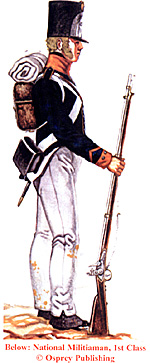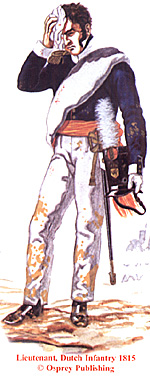The Netherlands Victory
Quatre Bras 1815
Wellington at Quatre Bras
by Peter Hofschröer, Germany
| |
Wellington’s ‘Dispatches’ contain no orders for any movement to Quatre Bras for 16 June 1815. There is however a published record of what troops he ordered there for 17 June, those orders being issued from Genappe on the evening of the 16th, once Wellington had gone there after that day’s fighting. He ordered his 2nd Division and Reserve Artillery to move to Quatre Bras on 17 June, his 4th Division and Lambert’s Brigade to Nivelles and Genappe, close to Quatre Bras. One can assume that Wellington did not order any of these formations to Quatre Bras on or before the afternoon of 16 June. At the outbreak of fighting at Quatre Bras on 16 June, Wellington had just one division of Netherlanders there, and the 5th Division was on its way.
Let us now try to establish when his other divisions were ordered there. According to the orders issued at 10 PM on 15 June, the 1st Division had been ordered ‘to move from Enghien to Braine le Comte.' The History of the First Guards describes what happened next, ‘…They reached Braine le Comte at nine in the morning, having been joined on the march by the second Brigade under Byng. The first Division, after experiencing some delay in marching through this town owing to its crowded state, halted for a few hours on its eastern side, while General Cooke, commanding the Division, made a
reconnaissance to the southward. On his return at midday he took upon himself the responsibility of continuing the march of the Division towards Nivelles, ten miles further, though the heat of the day was excessive, and the men were suffering from the weight of their packs. The Division of Guards were therefore again en route, and in due course arrived at three o’clock at a position within half-a-mile of Nivelles, where they expected to rest from their day’s march, but they had not halted many minutes and piled arms, before an Aide-de-camp brought an order to advance immediately.' [12]
The Prince of Orange, in Wellington’s absence, had ordered up this division to Quatre Bras. [13] Cooke’s leading companies
arrived at Quatre Bras at 5 PM. This particular quotation indicates that the order for it to move to Quatre Bras arrived after 3 PM; that is after the fighting had started.
Nivelles was less than an hour’s ride from Quatre Bras, so Wellington, being absent at that time, could not have issued the order. Furthermore, it is also clear that had Cooke not used his initiative in marching from Braine-le-Comte to Nivelles without orders, these men would not have been available that day. The credit for getting this division to Quatre Bras must go to the Prince of Orange and Cooke and not Wellington. The Brunswickers had been left resting and watering their horses at Genappe. About 2 PM, they received an order to march rapidly on Quatre Bras. [14]
This order would have been issued about 1.30 PM, after Wellington had left for Brye, so it must have come from the Prince of Orange. The 3rd Division had been ordered to march from Braine-le-Comte to Nivelles on 16 June. Lee’s History of the 33rd Foot, part of this division, noted that, ‘…by 2 o’clock, in the afternoon, the 33rd had passed through Nivelles, and then halted with the division for a cooked meal. The halt was, however, a short one, for the sound of heavy firing was heard in the direction of Quatre Bras’. [15]
Again, it is evident that this division was not expecting to have to move beyond Nivelles that day and that it was called up to Quatre Bras only after the fighting had started. The Reserve Cavalry, stationed much further to the rear, was moving that day from Ninove to Enghien as ordered. Once there, its commander, Uxbridge, sent
Captain Thomas Wildman of the 7th Hussars to Braine-le-Comte, the Prince of Orange’s headquarters, to get further orders. There was no news waiting here, so
Wildman rode on to Nivelles. Hearing the sound of guns coming from Quatre Bras, he then rode there. Here, he was sent back to Braine with orders for the Cavalry to move to Quatre Bras. It was about 4 PM when he got these orders, again, after the fighting had started. [16]
The Adjutant’s Diary of the 15th Hussars confirmed this. The entry for 16 June noted, ‘This morning at two o’clock orders were received for the advance of the British Army immediately upon Grammont &c. [i.e. the first orders issued between 6 and 7 PM] - upon the arrival of the British Cavalry at that place it was immediately ordered forward upon Enghien [The orders of 10 PM were evidently waiting for them at this point]: and when it arrived there it was immediately sent upon Nivelle.' [17]
The Journal of Lt.-Colonel Leighton-Cathcart-Dalrymple of the same regiment is more specific. He noted being woken at 5 AM on 16 June, moving off at 8 AM, arriving at Grammont at 11.30 AM, where he was ordered to Enghien. Expecting to be able to rest and feed there, he was instead ordered on to Braine-le-Comte. Once there, he was then ordered to Nivelles, where the sounds of battle were heard. The Cavalry arrived at Quatre Bras only late that night. [18]
Lord Greenock, then on Uxbridge’s staff, confirmed this series of events, writing,
‘…It will be admitted that is was scarcely to be expected that any of them could have reached at an earlier time of the day, more especially when it is remembered
that the different brigades were not ordered to move upon Nivelles or Quatre Bras by the shortest and most direct routes from their respective places of assembly in the
first instance, but were directed first to move upon Enghien, then by a subsequent order to proceed to Braine le Comte and afterwards to Nivelles, without any thing
having been said to indicate that greater speed was required than the ordinary rate of route marching, until they approached the last named place, when upon hearing the
firing the commanding officers were prompted of their own accord to push on at an accelerated pace’. [19]
The Nassau Contingent under Major-General von Kruse, three battalions strong, was in the Brussels area until 16 June. It left its cantonments early that day, but reached Quatre Bras only that evening. [20]
Wellington’s ‘Dispatches’ also contain the orders issued from Genappe on the evening on 16 June, once the Duke had gone there after that day’s fighting at Quatre
Bras. He ordered the 2nd Division and Reserve Artillery to Quatre Bras on 17 June. Furthermore, he ordered the 4th Division and Lambert’s Brigade to Nivelles
and Genappe, close to Quatre Bras. Evidently, these formations were not ordered to Quatre Bras before the start of the battle, as Wellington was later to claim in his ‘Waterloo Despatch.'
Other than parts of the Reserve, Wellington had not ‘directed’ a single man to Quatre Bras until after the fighting had started, let alone the ‘whole army.' He had
not expected to have to fight a major battle there on 16 June. He ordered the Brunswickers to Genappe just to block this bottleneck. He ordered parts of the Reserve
to Quatre Bras only after he had inspected his position there so he could secure his line of communication with Blücher. He did not order any further troops to that point until the evening after the battle. It was only thanks to the Prince of Orange that he had ‘sufficient force to engage the left of the French army.' The fact that Wellington was later able to claim the credit for a victory at Quatre Bras was due to the initiative of Saxe-Weimar, who contested the vital crossroad, to Constant Rebecque at headquarters, who confirmed this decision and to the Prince of Orange, who ordered up reinforcements to Quatre Bras while Wellington was meeting with Blücher at Brye. The fact that Wellington was able to fight a battle there was thanks to a German and two Netherlanders. He merely took the credit for the actions of others and never admitted his own errors of judgement.
[1] “Letters of the First Earl of Malmesbury, his Family and Friends, from 1745-1820”, vol 2, (London, 1870).
The editor wishes to express thanks to Jo Harbron of Osprey Publishing Ltd for permission to reproduce the colour plates and map featured in the article. They are
taken form Men at Arms No 98: Dutch Belgian - Troops of the Napoleonic Wars. Original Artwork was by Chris Warner.
More Netherlands Victory Quatre Bras 1815
Related
Quatre Bras 16th June 1815 [FE59]
|
 National Militiaman, 1st Class © Osprey Publishing.
National Militiaman, 1st Class © Osprey Publishing.
 Lieutenant, Dutch Infantry 1815 © Osprey Publishing
Lieutenant, Dutch Infantry 1815 © Osprey Publishing